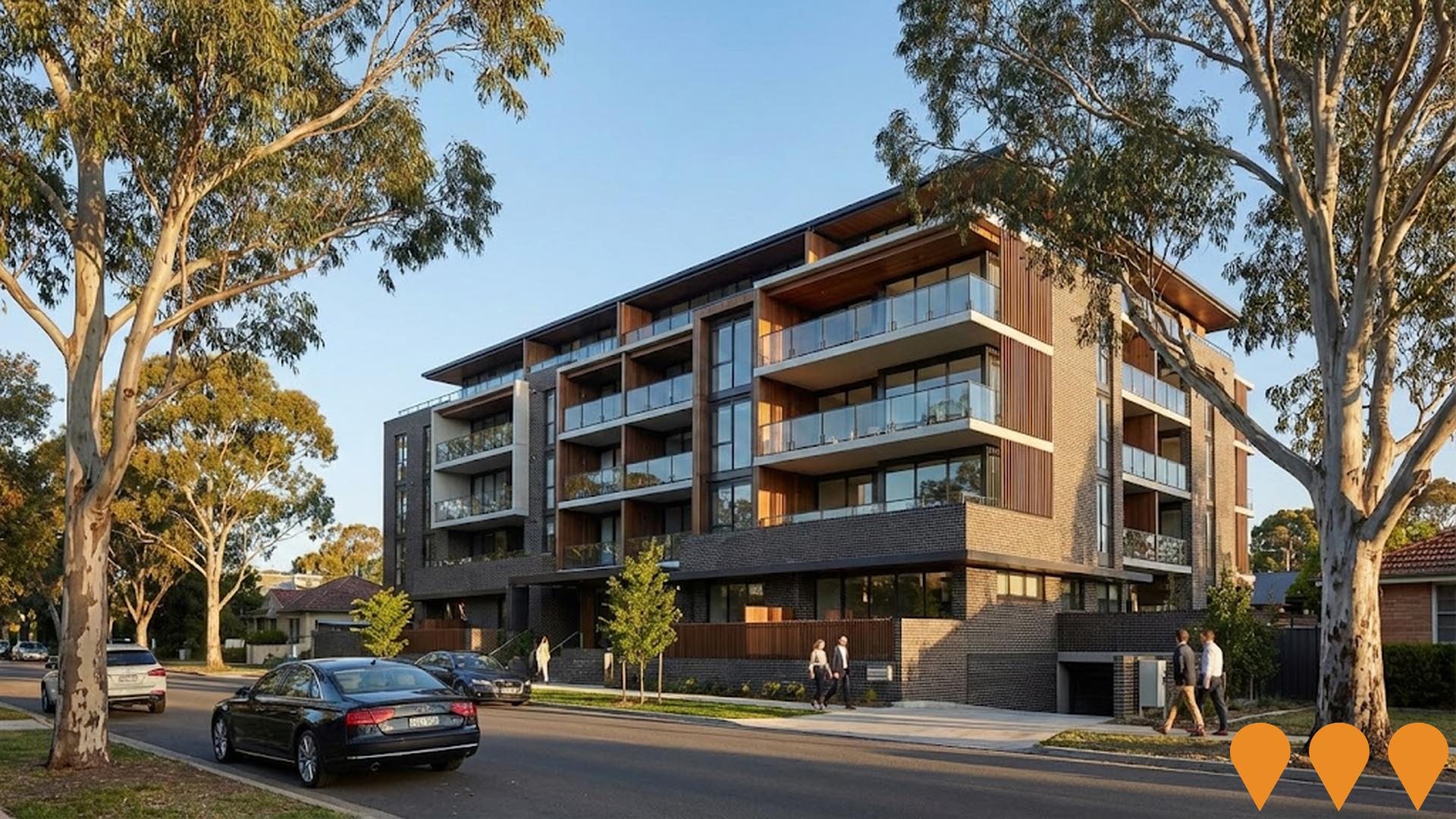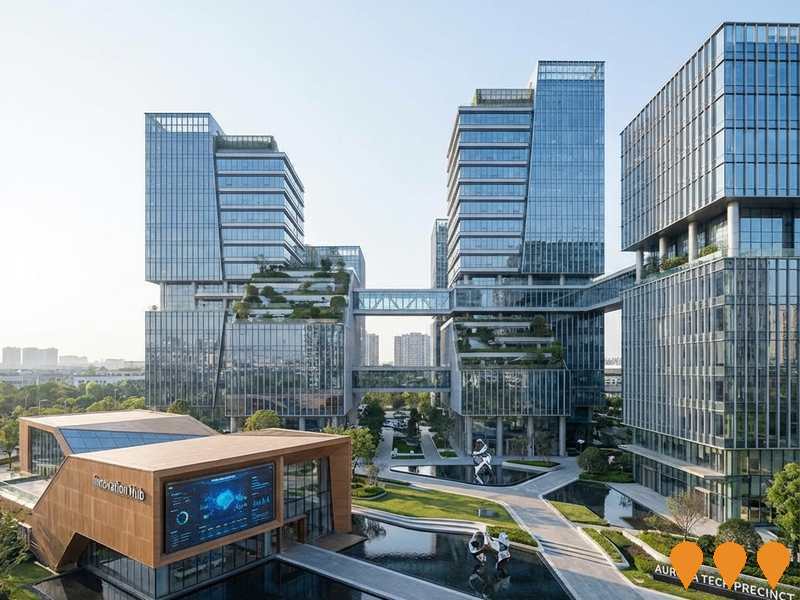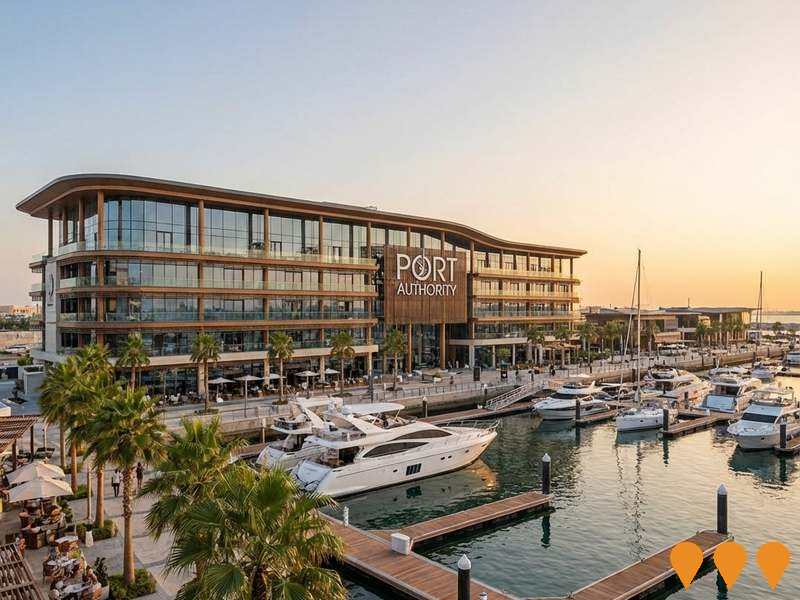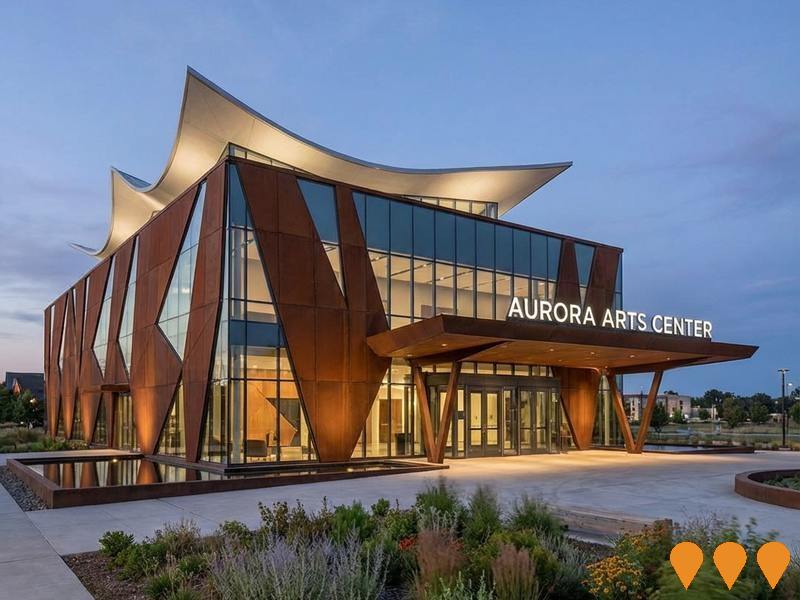Chart Color Schemes
est. as @ -- *
ABS ERP | -- people | --
2021 Census | -- people
Sales Activity
Curious about local property values? Filter the chart to assess the volume and appreciation (including resales) trends and regional comparisons, or scroll to the map below view this information at an individual property level.
Find a Recent Sale
Sales Detail
Population
Kingston lies within the top 10% of areas nationally in terms of population growth performance according to AreaSearch analysis of short and medium-term trends
Kingston ACT's population was around 7,338 as of Aug 2025. This increase from 6,579 in the 2021 Census reflects a growth of 759 people (11.5%). The ABS estimated resident population of 7,338 by June 2024 and an additional 13 validated new addresses since the Census date suggest this increase. This results in a density ratio of 5,241 persons per square kilometer, placing Kingston in the top 10% of national locations assessed by AreaSearch. Kingston's growth exceeded the state's (5.7%) and SA4 region, marking it as a growth leader. Overseas migration contributed approximately 42.4% of population gains, with all drivers being positive factors.
AreaSearch adopts ABS/Geoscience Australia projections for each SA2 area released in 2024 with a base year of 2022. For areas not covered and years post-2032, ACT Government's SA2 area projections with a base of 2022 are used. Based on projected demographic shifts, Kingston is forecast to increase by 3,168 persons to 2041, reflecting an overall increase of 43.2% over the 17 years.
Frequently Asked Questions - Population
Development
Residential development activity is slightly higher than average within Kingston when compared nationally
Kingston averaged approximately 31 new dwelling approvals annually over the past five financial years, totalling 157 homes. As of FY26, 0 approvals have been recorded. On average, 7.9 new residents arrived per dwelling constructed between FY21 and FY25. This indicates substantial supply lagging demand, leading to heightened buyer competition and pricing pressures.
Developers focus on the premium market with high-end developments, as evidenced by an average construction value of $682,000 for new homes. In FY26, $10.1 million in commercial development approvals have been recorded, suggesting balanced commercial development activity. Compared to Australian Capital Territory, Kingston shows approximately 56% of the construction activity per person and ranks among the 26th percentile nationally, resulting in relatively constrained buyer choice and supporting interest in existing dwellings. All new construction has comprised attached dwellings, focusing on higher-density living which creates more affordable entry points for downsizers, investors, and first-home buyers.
With around 3779 people per dwelling approval, Kingston reflects a highly mature market. Looking ahead, Kingston is expected to grow by 3168 residents through to 2041. Should current construction levels persist, housing supply could lag population growth, likely intensifying buyer competition and underpinning price growth.
Frequently Asked Questions - Development
Infrastructure
Kingston has moderate levels of nearby infrastructure activity, ranking in the top 50% nationally
Five projects identified by AreaSearch are expected to impact the local area, with key initiatives including Kingston Arts Precinct, Greenway Rise - The Establishment, Kingston Foreshore Precinct, and Griffith-Narrabundah Community Centre & Oval Upgrade.
Professional plan users can use the search below to filter and access additional projects.
INFRASTRUCTURE SEARCH
 Denotes AI-based impression for illustrative purposes only, not to be taken as definitive under any circumstances. Please follow links and conduct other investigations from the project's source for actual imagery. Developers and project owners wishing us to use original imagery please Contact Us and we will do so.
Denotes AI-based impression for illustrative purposes only, not to be taken as definitive under any circumstances. Please follow links and conduct other investigations from the project's source for actual imagery. Developers and project owners wishing us to use original imagery please Contact Us and we will do so.
Frequently Asked Questions - Infrastructure
Canberra Hospital Master Plan
Long-term transformation of Canberra Hospital campus (2021-2041). The new Critical Services Building (Building 5) opened in 2023. Multiple stages are now in construction or detailed planning, including SPIRE Stage 1 (new emergency, surgical and intensive care facilities) and ongoing campus renewal works to deliver modern clinical facilities.

Kingston Arts Precinct
New $36 million performing and visual arts hub including a 250-seat theatre, gallery, rehearsal spaces and artist studios within the historic Fitters Workshop and former Transport Depot.
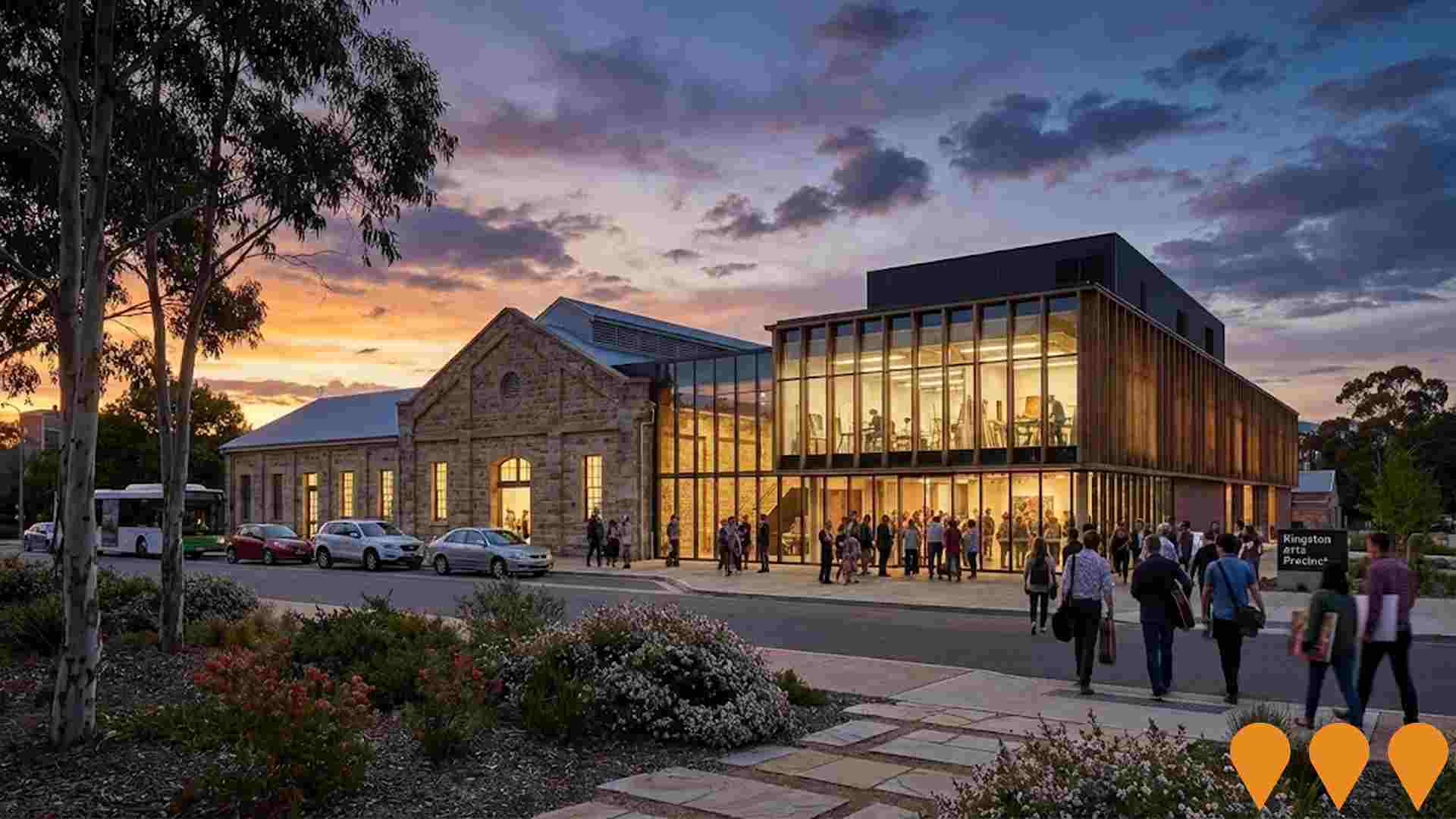
Kingston Foreshore Precinct
Award-winning mixed-use waterfront precinct featuring premium apartments, restaurants, bars, retail, public art and parklands along the southern shore of Lake Burley Griffin.
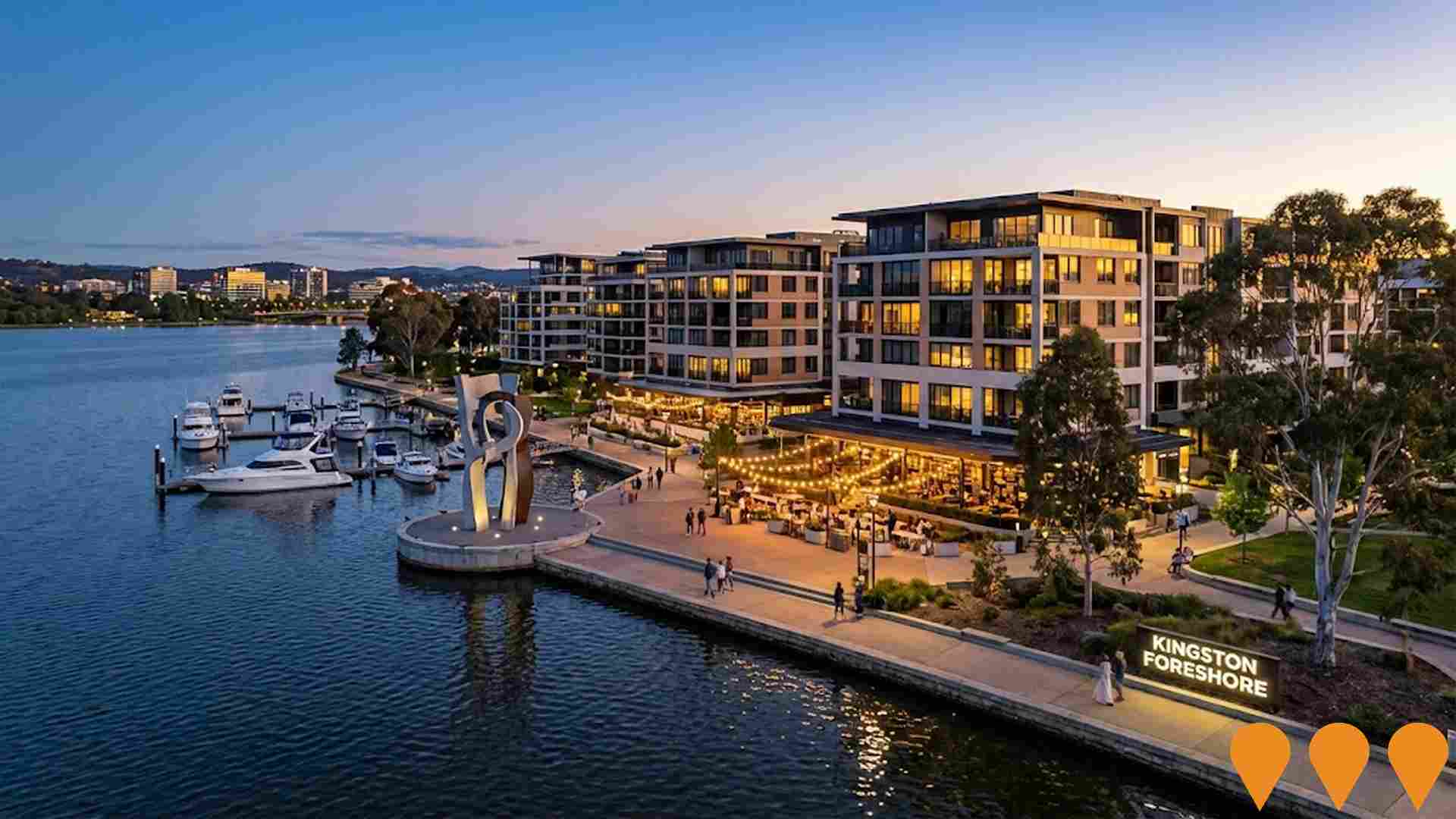
National Security Office Precinct (York Park)
A multi-agency office precinct at York Park in Barton to accommodate up to 5,000 workers from several national security and other Commonwealth agencies, with hospitality and retail amenities. Early site works commenced in late 2024 and the York Park car parks closed on 12 Feb 2025. Main construction is underway, led by Lendlease as Managing Contractor. Practical completion is targeted for late 2028 with occupation from 2029.

Enhanced bus and light rail corridors (Belconnen & Queanbeyan to Central Canberra)
ACT is progressing an integrated program to enhance high-frequency bus and future light rail corridors that link Belconnen and Queanbeyan with central Canberra. Light Rail Stage 2A (City to Commonwealth Park) commenced construction in early 2025 with services targeted from 2028, while planning and approvals continue for Stage 2B to Woden. The ACT Government has acknowledged and is planning upgrades for the Belconnen-to-City bus corridor as groundwork for a future east-west light rail Stage 3, and is coordinating cross-border public transport initiatives with NSW through the Queanbeyan Region Integrated Transport Plan and the ACT-NSW MoU for Regional Collaboration.
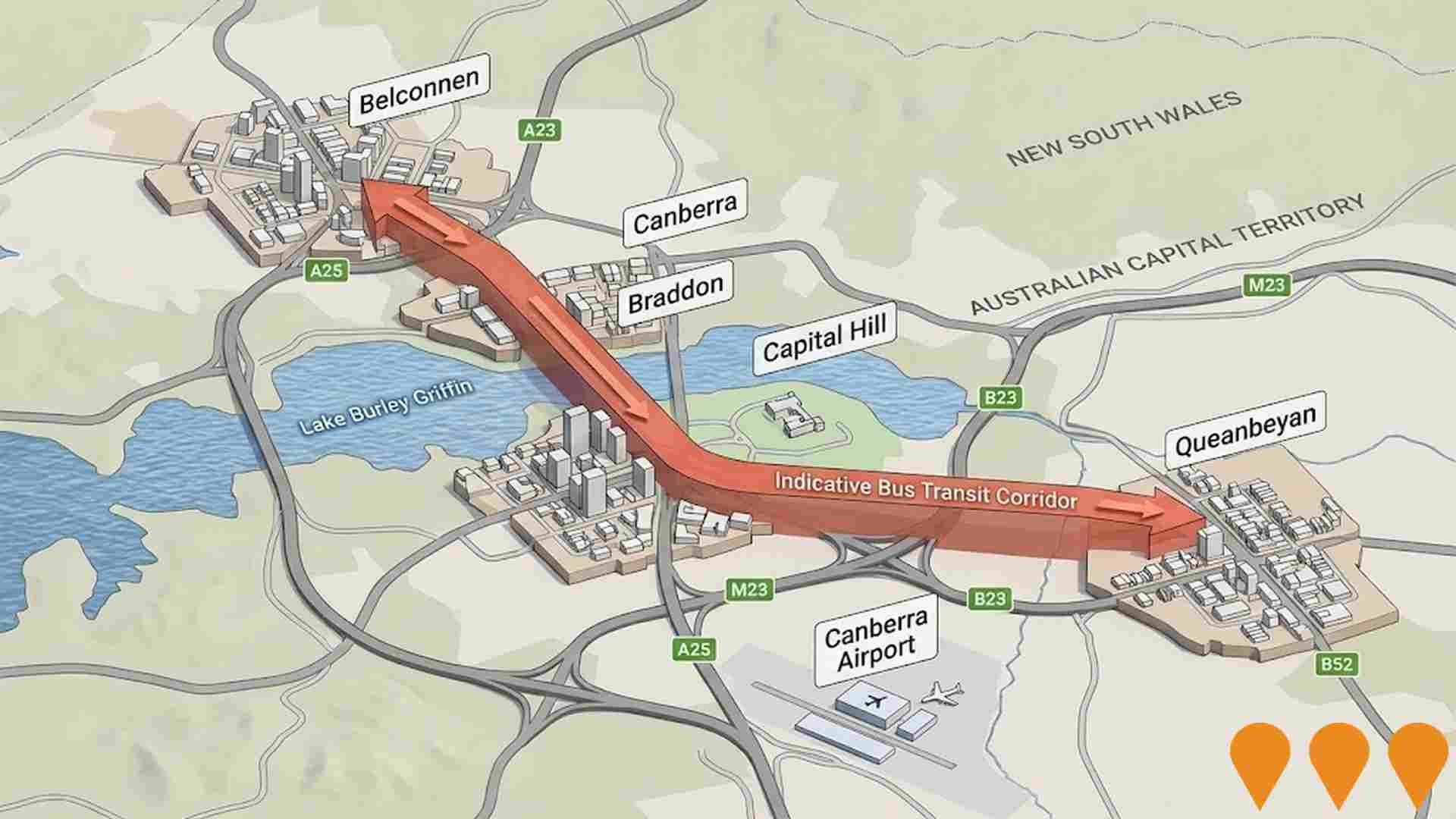
Griffith-Narrabundah Community Centre & Oval Upgrade
New multi-purpose community centre and upgrades to Griffith Oval including new pavilion, play spaces and improved amenities serving both Griffith and Narrabundah residents.

Queanbeyan Regional Integrated Transport Plan
Comprehensive transport planning initiative with 64 key actions for next 10 years. Addresses road safety, active transport connectivity, public transport availability, and future transport needs. Improved connections between Queanbeyan and ACT.
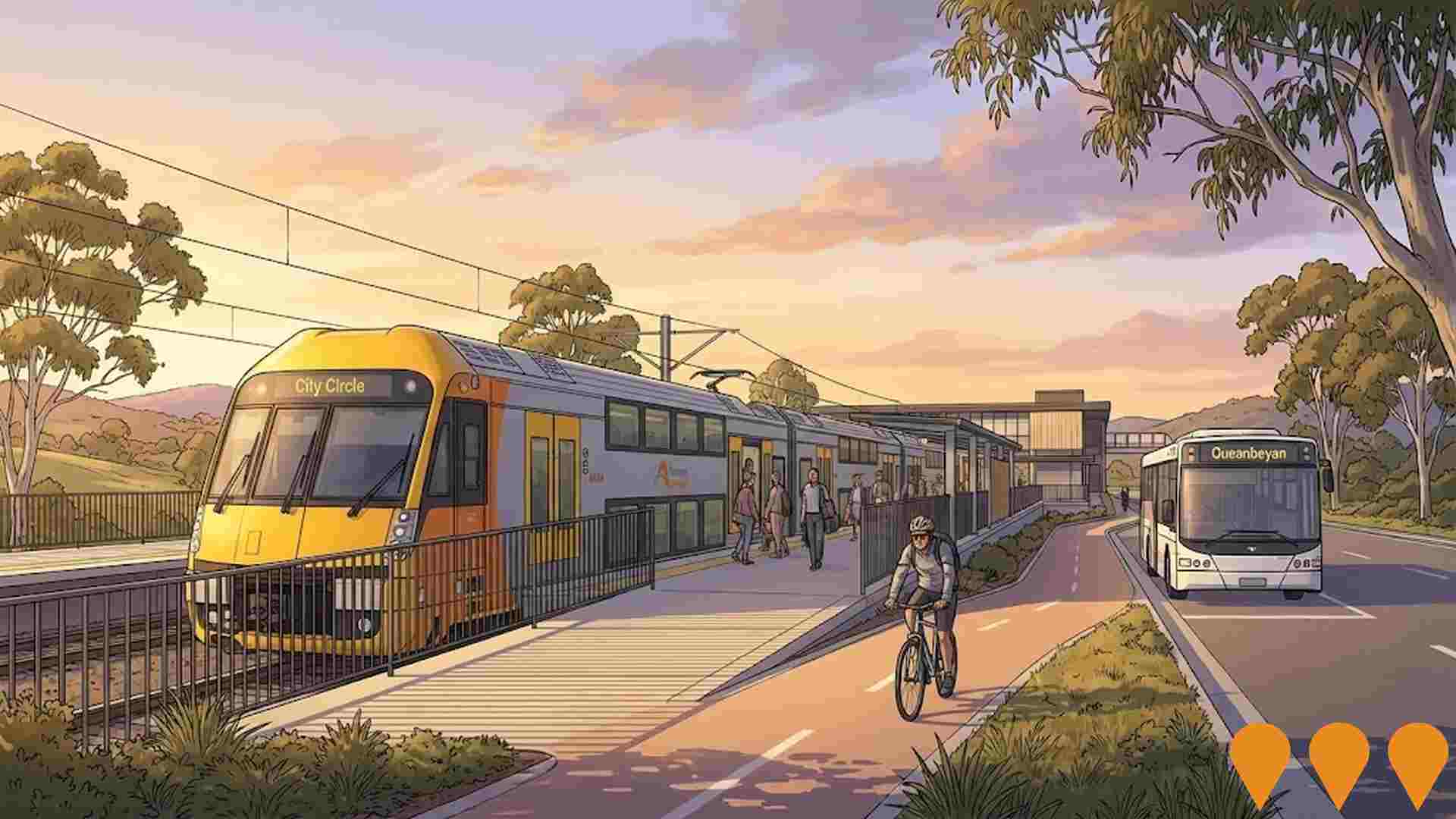
Greenway Rise - The Establishment
Luxury boutique residential development of 48 apartments in the heart of Kingston, designed by Fender Katsalidis with interiors by Ministry of Interior Architecture.
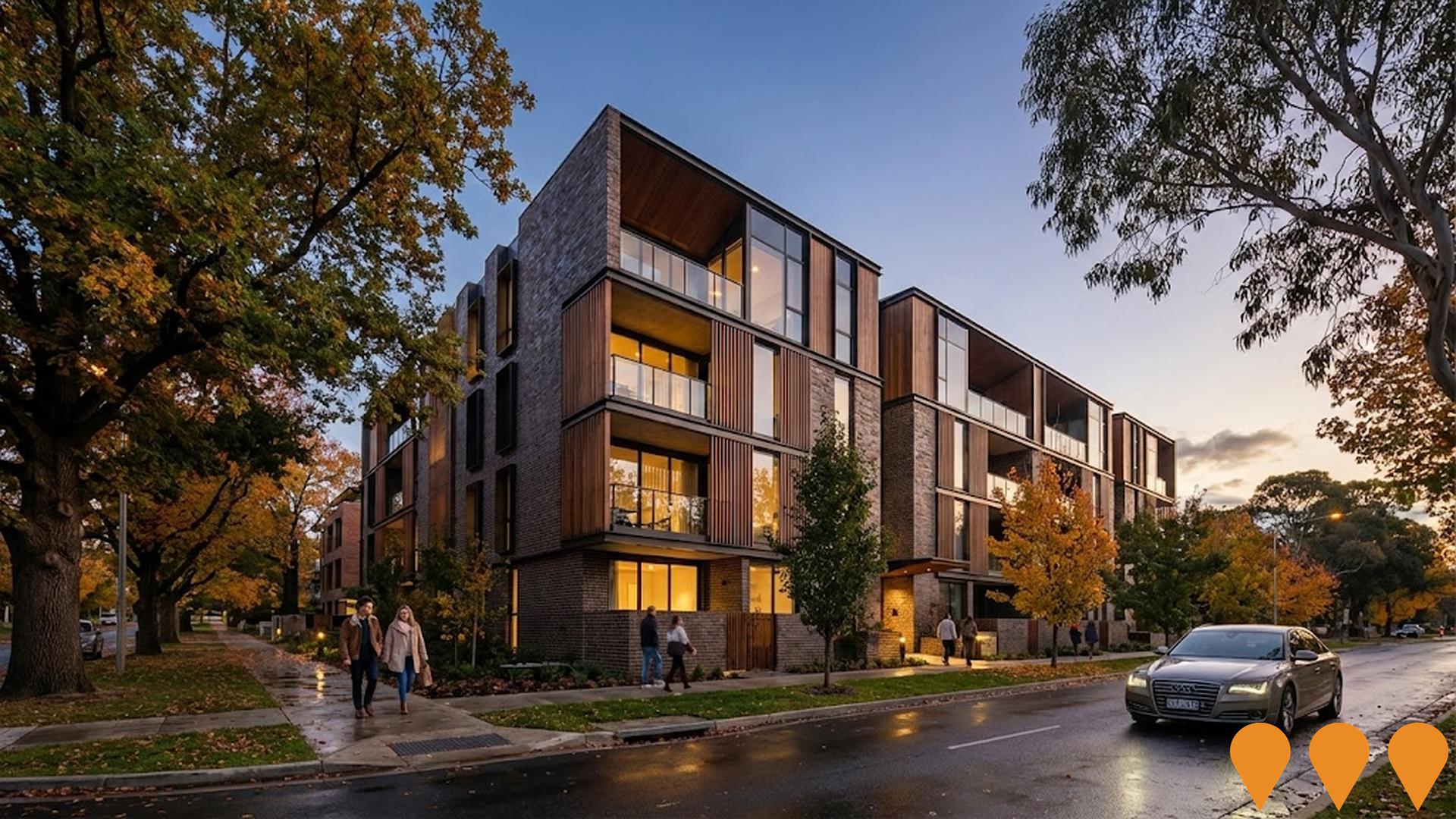
Employment
Employment conditions in Kingston rank among the top 10% of areas assessed nationally
Kingston ACT has a highly educated workforce with strong representation in professional services. Its unemployment rate is 0.6% and it experienced an estimated employment growth of 1.8% over the past year.
As of June 2025, there are 5,623 residents employed, with an unemployment rate of 2.8%, which is below the ACT's rate of 3.4%. The workforce participation rate in Kingston is 75.3%, compared to the ACT's 69.6%. Dominant employment sectors include public administration & safety, professional & technical services, and health care & social assistance. Public administration & safety has a particularly strong presence with an employment share of 1.5 times the regional level, while construction has limited presence at 2.8% compared to the regional average of 6.8%.
Many residents commute elsewhere for work based on Census data. Between June 2024 and June 2025, employment increased by 1.8%, labour force grew by 1.6%, resulting in a 0.2 percentage point decrease in unemployment. In comparison, the ACT recorded an employment growth of 1.9% with a 0.3 percentage point decrease in unemployment during the same period. Jobs and Skills Australia's national employment forecasts from May 2025 indicate that employment is projected to expand by 6.6% over five years and 13.7% over ten years. Applying these projections to Kingston's employment mix suggests a local growth of approximately 6.3% over five years and 12.9% over ten years, though this is a simple weighting extrapolation for illustrative purposes and does not account for localized population projections.
Frequently Asked Questions - Employment
Income
The economic profile demonstrates exceptional strength, placing the area among the top 10% nationally based on comprehensive AreaSearch income analysis
AreaSearch's latest postcode level ATO data for financial year ending June 2022 shows median income in Kingston at $98,743 and average income at $121,767. This compares to Australian Capital Territory's median income of $68,678 and average income of $83,634. Based on Wage Price Index growth of 13.6% from July 2022 to September 2025, estimated current incomes in Kingston are approximately $112,172 (median) and $138,327 (average). Census data indicates household, family, and personal incomes in Kingston rank between the 90th and 99th percentiles nationally. Income distribution shows 40.8% of Kingston's population falls within the $1,500 - $2,999 range, similar to surrounding regions at 34.3%. A substantial proportion, 43.1%, earns above $3,000 per week, indicating strong economic capacity. High housing costs consume 16.2% of income, but strong earnings place disposable income at the 89th percentile nationally. Kingston's SEIFA income ranking places it in the 10th decile.
Frequently Asked Questions - Income
Housing
Kingston features a more urban dwelling mix with significant apartment living, with a higher proportion of rental properties than the broader region
Kingston's dwelling structure, as per the latest Census, consisted of 3.0% houses and 96.9% other dwellings. In comparison, the Australian Capital Territory had 40.7% houses and 59.3% other dwellings. Home ownership in Kingston was at 17.8%, with mortgaged dwellings at 30.8% and rented ones at 51.4%. The median monthly mortgage repayment was $1,950, lower than the Australian Capital Territory average of $2,275. The median weekly rent in Kingston was $510, compared to the Australian Capital Territory's $500. Nationally, Kingston's mortgage repayments were higher at $1,950 versus Australia's average of $1,863, while rents were substantially higher at $510 against the national figure of $375.
Frequently Asked Questions - Housing
Household Composition
Kingston features high concentrations of lone person households and group households, with a lower-than-average median household size
Family households account for 48.3% of all households, including 10.7% couples with children, 30.9% couples without children, and 6.1% single parent families. Non-family households constitute the remaining 51.7%, with lone person households at 44.4% and group households comprising 7.2% of the total. The median household size is 1.8 people, which is smaller than the Australian Capital Territory average of 2.2.
Frequently Asked Questions - Households
Local Schools & Education
Kingston performs slightly above the national average for education, showing competitive qualification levels and steady academic outcomes
Kingston's residents aged 15+ have a higher proportion with university qualifications (71.5%) compared to Australia (30.4%) and the SA4 region (46.8%). Bachelor degrees are most prevalent at 38.2%, followed by postgraduate qualifications (25.2%) and graduate diplomas (8.1%). Vocational pathways account for 15.1% of qualifications, with advanced diplomas at 8.0% and certificates at 7.1%. Residents' educational participation is high, with 27.5% currently enrolled in formal education: 14.1% in tertiary, 4.5% in primary, and 3.5% in secondary education.
Educational facilities are primarily located outside Kingston's immediate boundaries, necessitating families to access schools in neighboring areas.
Frequently Asked Questions - Education
Schools Detail
Nearby Services & Amenities
Transport
Transport servicing is good compared to other areas nationally based on assessment of service frequency, route connectivity and accessibility
Kingston has 24 active public transport stops, serving a mix of train and bus routes. These stops are serviced by 48 individual routes, providing a total of 1,753 weekly passenger trips. Transport accessibility is good, with residents typically located within 200 meters of the nearest stop.
Service frequency averages 250 trips per day across all routes, equating to approximately 73 weekly trips per stop.
Frequently Asked Questions - Transport
Transport Stops Detail
Health
Kingston's residents are extremely healthy with very low prevalence of common health conditions across all age groups
Analysis of health metrics shows strong performance throughout Kingston with very low prevalence of common health conditions across all age groups. The rate of private health cover was found to be exceptionally high at approximately 79% of the total population (5826 people), compared to the national average of 55.3%.
The most common medical conditions in the area were mental health issues and asthma, impacting 9.8% and 8.6% of residents respectively. 71.8% of residents declared themselves completely clear of medical ailments, compared to 69.8% across Australian Capital Territory. The area has 13.9% of residents aged 65 and over (1019 people), which is lower than the 19.9% in Australian Capital Territory. Health outcomes among seniors are particularly strong, performing even better than the general population in health metrics.
Frequently Asked Questions - Health
Cultural Diversity
Kingston was found to be more culturally diverse than the vast majority of local markets in Australia, upon assessment of a range of language and cultural background related metrics
Kingston's population is more culturally diverse than most local markets, with 26.9% born overseas and 18.6% speaking a language other than English at home. Christianity is the predominant religion in Kingston, comprising 34.0% of its population. Judaism is overrepresented in Kingston compared to the Australian Capital Territory, making up 0.7% versus 0.6%.
The top three represented ancestry groups are English (25.8%), Australian (19.9%), and Irish (11.0%). Notably, French (1.2%) and Russian (0.6%) ethnicities are overrepresented in Kingston compared to regional averages of 0.9% and 0.4%, respectively.
Frequently Asked Questions - Diversity
Age
Kingston's population is younger than the national pattern
Kingston has a median age of 35 years, matching the Australian Capital Territory figure but slightly below Australia's median age of 38 years. Compared to the Australian Capital Territory, Kingston has a higher proportion of residents aged 25-34 (29.1%) but fewer residents aged 5-14 (3.8%). This concentration of 25-34 year-olds is significantly higher than the national average of 14.5%. Between the 2021 Census and the present, the proportion of Kingston's population aged 75-84 has grown from 3.3% to 5.2%, while the 35-44 age group increased from 18.3% to 19.7%. Conversely, the 15-24 age group has declined from 9.2% to 7.8%, and the 25-34 age group has decreased from 30.4% to 29.1%. Population forecasts for Kingston in 2041 suggest substantial demographic shifts, with the strongest projected growth in the 35-44 age cohort, which is expected to increase by 43%, adding 613 residents to reach a total of 2,057.

